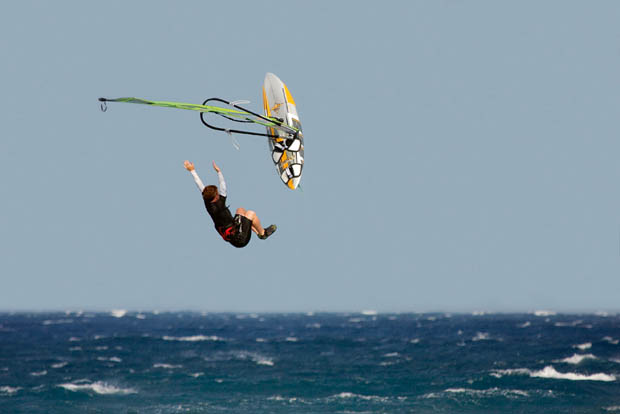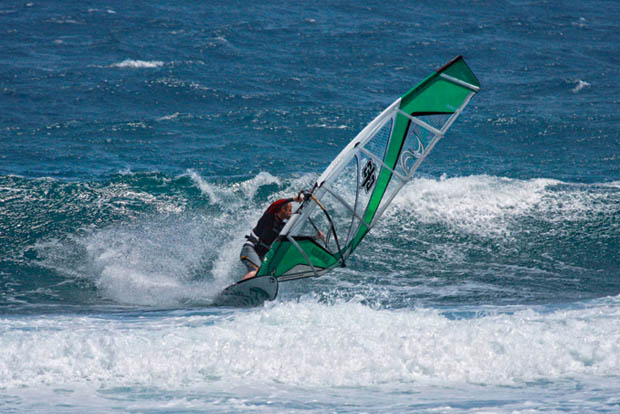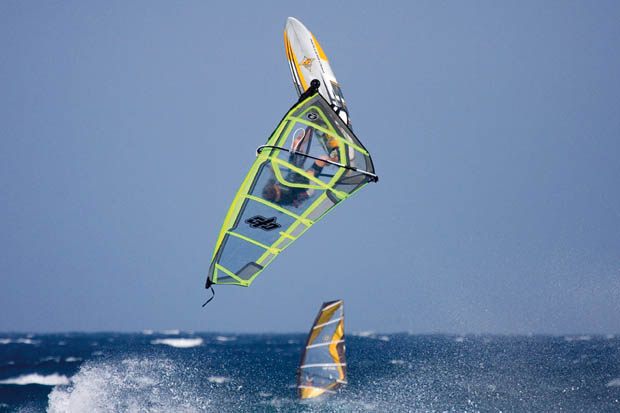
This wave sail review is a test with a difference. Sails do seem to generate more of a subjective viewpoint than boards, in that we all have our own preferences as to the way a sail should feel. So instead of the editorial ‘voice’ in the write-ups (other than in the ‘summary’ sections which give the overall picture that we could all agree on), we’re giving you the opinion of each tester. It allows us to air our individual preferences a little more, and should give the reader a better insight into how sails can affect sailors in different ways.

The Personnel:
For this test we were very pleased to welcome Matthew Burridge as a tester. Matthew is a well-known custom sail-maker based near Hayle in Cornwall. He owns and runs Demon Design sails, and while best known for his race sails he has a wealth of experience in designing and making windsurfing sails of all types over many years. He is also particularly well known for his forthright and independent viewpoint – unafraid to hold views that run counter to popular opinion, and certainly never afraid of airing them! Matthew is a competent wavesailor too, and at 93kg is representing the heavier sailor. It was refreshing to have him along on the trip and we hope his input will considerably widen the focus of the team.
Emile Kott has been a tester with us for several years now. Aged 29, he is the most advanced sailor of the team, looping both ways on both tacks and waveriding very tidily. He’s a medium heavy at about 80kg.
Ed Frisby is similar in age, weight and beauty to Emile. He has accompanied us as an occasional tester on many wave trips and chips in with the voice of the weekend warrior, although as a man who can duck tack and vulcan (okay, okay, he’s done a couple of spocks too!) he’s no mean sailor.
Ian Leonard is the Test Editor and lends the voice of experience to the mix, having tried more sails over 25 years of testing than he cares to remember. Ian weighed in at a diminutive 73kg at the start of the trip and needs feeding up.
Subjectivity & Preference in Sail Testing
“There’s no such thing as a bad sail these days” is a phrase that we often hear, usually followed by something like “sail preferences are just a question of personal choice”. As a long term tester I think that there is some truth in this, but having tested for so many years with many different testers and guest testers in many different conditions, it is very clear that over certain periods (usually associated with a particular designer) certain brands or ranges will be right up there in popularity with pretty much everyone. Time after time a convincing majority of testers and guesters will put two or three particular ranges up there in their top two or three favourites. This test saw the Gaastra wave sails as the universally popular stand-out – and we are prepared to bet that this would have been the case over pretty much any size sample of sailors and conditions.
The converse can also be true and certain ranges will rarely feature on anyone’s preference list. Does this mean they are bad sails? Not usually. Some might suffer by comparison with the general standard, but if compared with sails of ten years ago they are still pretty darned good! Also there are sails that cater for a minority, either in terms of personal taste or type of performance. For example, in this test there is the new Kauli Seadi sail, the Fly. Our testers didn’t find it very comfortable for ordinary sailing in stronger or gustier winds – an important and relevant finding because British winds do tend to be quite gusty! It is however an extremely light and manoeuvrable sail that demonstrated in the little flashes of waveriding excellence it gave us that it would be a great down-the-line sail for the right sailor in the right location.
Personal Choice There is then the issue of personal preference. Many sailors just like certain types of sail, and there are some very good reasons for this.
Sailor weight: This makes a huge difference. For example, let’s say there’s a lightweight sailor out on a 4.7m, and a heavyweight out on a 5.3m of the same range. Same day, same conditions, and they’re both comfortably powered for their size. But the 5.3m is actually being used at the upper end of its wind range, while the 4.7m is at the lower end. Consequently, heavier sailors generally like their sails to be more stable because they use them in more wind, and they usually like relatively fuller sails because they develop more power.
The consequent heaviness in manoeuvring (due to the fuller profile) is less of a drawback to the heavier sailor because his extra strength and bulk allows him to handle the sail more easily. Consequently heavier sailors typically seem to like stiffer, fuller sails than lighter sailors, who will use a given size in considerably less wind, and thus be much more sensitive to how light and manoeuvrable the sail feels, and thus may look for a flatter and possibly twitchier sail than the heavyweight.

Sailor skill: Skill can make a difference, and skilled sailors are often happier using flatter sails because they are capable of putting them at the correct sheeting angles to develop maximum power, and also because they are able to take better advantage of their extra manoeuvring potential.
However, less advanced sailors tend to like sails with a very pronounced centre of effort and a relatively deep, forward profile. This gives a very obvious pulling point and requires less skill to turn the drive into forward motion, allowing a much greater margin of error on sheeting angles.
Simple preference:
There’s also the fact that some sailors simply like certain types of sail! This might be because they are used to a type of performance, perhaps because their own long term sails have been that way. Alternatively it may just suit their style of sailing. For example, Matt tends to like quite full sails that have a fairly rigid foil and a relatively high centre of effort. Part of this will be due to his weight and part to simple preference. Tris Best, the co-owner of OTC, has a preference for sails that are quite taut foiled and direct. Personally I prefer sails with a fair degree of flexibility. Another very good sailor who sails at my local beach occasionally bags out his sails to a ridiculous degree with masses of negative outhaul and low downhaul. It is a set that I couldn’t live with and he is aware of its strangeness, but just really likes it! In some cases these preferences will push sails unusually high up or low down a particular sailor’s list of favourites. Nevertheless, really good sails still tend to float to the top of the favourites lists despite their style, because good performance is ultimately more telling than style preferences.
Conclusion:
In this test we are not including an ‘Our Favourites’ section because our individual favourites should be clear from our personal assessments of the sails. However, the key message of this test is that some sail ranges will suit you better than others. So don’t choose your sails on colour. Don’t choose them on brand image. Do your best to try them out for yourself! Make friends with people who have sails on your shortlist, and beg / borrow / steal some water time. But it is not really enough to use a sail for one outing. Sails only really reveal their true character after two or three outings in varied conditions. To this end we absolutely must recommend the OTC centre in Tenerife from where we carried out this test. They have all the major ranges of sails rigged and ready to go on their recommended masts. You can change size and keep the same range or change range and keep the same size and thus really start to get to grips with things. Over the years we have noticed that very few of our guest testers really explore the performance of sails, preferring to try every board before putting much time and effort into trialling sails. And when they do get round to trying out sails they tend to find that it takes a lot longer to get to grips with the differences and variables of sail performance. This is partly because the set of a sail is so variable, but it is also because conditions can effect a sail so significantly – making it feel great one minute and awful the next. It really does take longer to fully get to know a sail than a board.
However, having just carried out a test on the current crop of waveboards and wave sails I would say this: If I was to be randomly given any of the waveboards we tested this year I would be confident of getting a board that I would really enjoy sailing. It may be better suited to riding or jumping and may be high grip or low grip and may be better with bigger or smaller sails, onshore or cross-shore wind etc, etc, but overall it would still be a great board. However, if I was to be randomly given any of the sails we have tested this year I would be much more concerned. For me personally there are three or four sail ranges that I would be very happy to own. If I had to use one of the others there are some that I’m sure I would get used to and enjoy my sailing with almost as much, but there are others that I would struggle to really enjoy. In either case I would be very aware that another sail would be giving me significantly more suitable performance and I wouldn’t really be happy about it.
So the message is to not be apathetic in your choosing of sails. Yes, boards are more fun (and easier) to test out but in my opinion sails are more crucial to your enjoyment of the sport. Don’t assume that one sail is much like another, and don’t trust the advice of anyone who hasn’t spent quite some time trying out a wide range of different brands and ranges.

The Test:
The test was carried out in El Médano, Tenerife, in conjunction with OTC. Once again they hosted us immaculately and the extensive range of equipment they have was instrumental in letting us carry out the test. If there are any sails in this test (or even quite a few that are not in this test) you would like to try, there are few better places to do it.
The Sails:
All the sails on test other than the Maui Sails products were tested in both the 5.3/5.4m and 4.7/4.8m size. This meant that we could try the sails in a much wider variation of wind strengths, thus giving more testing time and a more detailed and thorough test. It also allows us to get a picture of the consistency between the different models in the range so that we don’t happen to just get the best or worst sail of the range and base all our findings on that. We were lucky with the wind, ending up getting an almost equal amount of use out of both sizes. El Médano is an onshore wave venue with relatively strong winds that can be quite gusty in the bay, it is therefore not dissimilar to typical British conditions.
Missing Sails:
Unfortunately a couple of well known brands are absent from this test line-up. The Naish wave sails were not quite ready in time for this test. We will attempt to put right this disappointing omission of a strong brand in a ‘catch up’ test a bit later in the season. Ezzy and Severne sails are currently requesting that we don’t test their sails. This is a commercial decision taken by their owners or UK importers which we have to accept despite wishing to include them in our tests.

